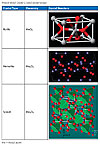The Use of Mixed Metal Oxide Pigments in Industrial Coatings
Mixed metal oxide pigments offer a multitude of benefits for the coatings formulator, including excellent outdoor durability, chemical resistance and heat stability.
Mixed metal oxide (MMO) pigments, also known as complex inorganic color pigments (CICPs), have been around since the early 1800s. Their use in the ceramic and pottery industries is well known due to their overall inertness, which contributes to outstanding heat, chemical and UV resistance. The use of MMOs in industrial coatings is less common and more for special purposes. This paper will discuss the benefits of formulating coatings with MMOs as a replacement for, or in conjunction with, the more common organic types.
 Courtesy of the Powder Coating Research Group, Inc. Courtesy of the Powder Coating Research Group, Inc. |
| Table 1 Click to enlarge |
Mixed metal oxide pigments are compounds comprised of a group of two or more metals and oxygen. The most common crystal structures are rutile (MeO2) hematite (Me2O3) or spinel (Me3O4). Metals commonly present include: cobalt, iron, trivalent chrome, tin, antimony, titanium, manganese and aluminum. Different metal combinations produce a wide spectrum of hues ranging from black to brown to green, blue, yellow and red. All MMOs are produced by a calcination process consisting of an intimate mixture of appropriate metal precursor materials being fired at temperatures of 800 to 1300 °C. It is this calcining process that creates the extremely stable metal oxide bonds. The chemical stability of these bonds affords the outstanding durability of this class of color pigments.
UV Durability
The chemical inertness of inorganic MMOs renders their excellent resistance to UV radiation and the elements encountered in the most extreme outdoor environments. Most organic pigments degrade when exposed for more than a few years in UV-intense tropical environments. High-performance organic pigments that do provide acceptable durability are typically very expensive, commanding two to four times the cost of a metal oxide pigment. MMOs are therefore the colorant material of choice for architectural coatings requiring extremely high durability such as the performance specified in AAMA 2605-05 (Architectural Aluminum Manufacturers Association). This specification calls for maintenance of color and gloss after 10 years exposure in south Florida.
Chemical Resistance
The exceptionally stable chemical bonds characteristic of MMO pigments make them insoluble in most chemicals including strong acid and alkali, and virtually all organic solvents. Because of this insolubility, coatings formulated with MMOs will not lose color due to pigment degradation even with the most extreme exposure to aggressive chemicals. Atmospheric pollution including acid rain, volcanic fallout and waste incineration does not chemically attack these pigments. Moreover, coatings requiring resistance to strong chemical exposure such as laboratory and chemical manufacturing facilities can use MMOs and be assured of color stability.
Heat Resistance
The thermal stability of MMOs is well known in the ceramic and pottery industries. This class of pigments is processed for hours at temperatures ranging from 800 to 1300 °C in their manufacture. Consequently, they are chemically and color stable at these temperatures in service. As mentioned, the ceramic industry has used mixed metal oxides for color glazes for centuries. The glazes used in ceramics are regularly fired at temperatures of 985 to 1300 °C (1800 to 2350 °F) without significant color shift. The use of MMOs in thermally stable coating formulations such as those based on silicone (polysiloxane) resins brings a palette superseding the traditional black and silver high-heat choices. This brings an attractive array of color possibilities to the designer of specialized and sport transportation such as motorcycles, ATVs and jet skis.
Infrared Reflectivity
 Courtesy of the Powder Coating Research Group, Inc. Courtesy of the Powder Coating Research Group, Inc. |
| Table 2 Click to enlarge |
Metal oxide pigments possess unique spectroscopic properties. The infrared reflective characteristics of the cobalt chromite, cobalt titanate and chrome oxide greens make them ideal for non-detectable camouflage coatings. Common organic green pigments such as those based on copper phthalocyanine strongly absorb infrared radiation and make them a poor choice for military coatings.
Solar Reflectivity
One of the more exciting developments in MMO technology is the recognition of how this pigment technology can provide colors that significantly reflect the infrared energy generated by the sun. Colored materials, including pigments and dyes, absorb and reflect radiation in the visible range (approximately 400 to 700 nm). They also inherently reflect and absorb in the near-infrared region (700 to 2500 nm) of radiation. It is this range that is responsible for the increase of temperature experienced when colored surfaces are exposed to sunlight.
Organic pigments, especially carbon black and phthalocyanine types (blue and green), absorb strongly in this region, causing a significant increase in surface temperature. This increased temperature is deleterious for a number of reasons. Most important are coatings used for architectural structures such as roofing and cladding. The heat increase associated with highly absorptive organic pigments causes the temperature of the interior of buildings to rise. This obviously translates into higher cooling costs in summer months. MMOs provide substantially higher infrared reflectivity (total solar reflectivity – TSR) and therefore stay cooler in the sunlight. The Lawrence Berkeley National Laboratory has conducted extensive research and has qualified a large amount of MMOs as replacements for poorly reflective organic pigments (http://coolcolors.lbl.gov/LBNL-Pigment-Database/database.html).
IR reflective pigmentation has other practical uses. Maintaining cooler surfaces of playground equipment, park benches, outdoor sports facilities and bus stops provides more comfort and a safer surface in sunny locales. Furthermore, cooler surfaces on utility cabinetry such as cable junction boxes, electrical enclosures and outdoor generators keeps internal components cooler and increases product longevity and minimizes service calls.
Cooler coating temperatures not only provide comfort and increased component longevity but also improve the overall durability of the coating system. The lower temperatures experienced in service keep the coating binder cooler and thus slow the chemical degradation of the polymers in the coating.
Highest reflectivity is characteristic of yellows (PY 53 and PBrn 24), browns (PBrn 33 and PBrn 35), some greens (PG 17) and some blacks (PG 17 and PBrn 35). Blues (PB 28 and PB 36) and greens (PG 17, PG 26 and PG 50) provide reasonable alternatives to traditional organic types.
Organic Pigment Extenders
Mixed metal oxides can enhance the durability and lower the cost of coatings formulated with high-performance organic pigment systems. This is especially relevant in bright yellow, orange and red color spaces. These organic hues not only are relatively weak in hiding (opacifying) properties, they typically possess high oil absorption, which affect rheological properties especially at the high concentrations needed to achieve acceptable opacity. MMOs have relatively low oil absorption compared to their organic counterparts, thus providing improved flow and leveling in industrial coatings. This is especially true in powder coatings, which rely on resin melt viscosity to achieve a smooth finish.
The incorporation of pigment yellow 53 or pigment brown 24 (yellow buff) typically lowers the overall cost of pigmentation for an architectural or automotive coating while maintaining or improving durability. In some cases an improvement in hiding can be realized.
Tinting in Pastels
In general MMOs are weaker and somewhat lower in tint strength compared to organic pigments. Because of this, they are an excellent choice to tint white and pastel colors. This is especially true when compared to difficult-to-disperse organic pigments such as phthalocyanine blues and greens and carbon black.
Summary
Mixed metal oxide pigment technology is well known and time-tested in the decorative ceramics industry. Its widespread use in organic coatings has not yet reached its full potential. These pigments offer a multitude of benefits for the coatings formulator, including excellent outdoor durability, chemical resistance and heat stability. Inherent infrared reflective properties make them a good foundation for camouflage and “cool” coatings. The low oil absorption characteristic of MMOs allow them to reduce the concentration of high-cost, high-performance organic pigments with a positive effect on coating rheology. The coatings formulator is therefore strongly encouraged to include this class of pigments in his or her formulating toolkit.
For more information, visit www.masoncolorpigments.com.
Looking for a reprint of this article?
From high-res PDFs to custom plaques, order your copy today!






